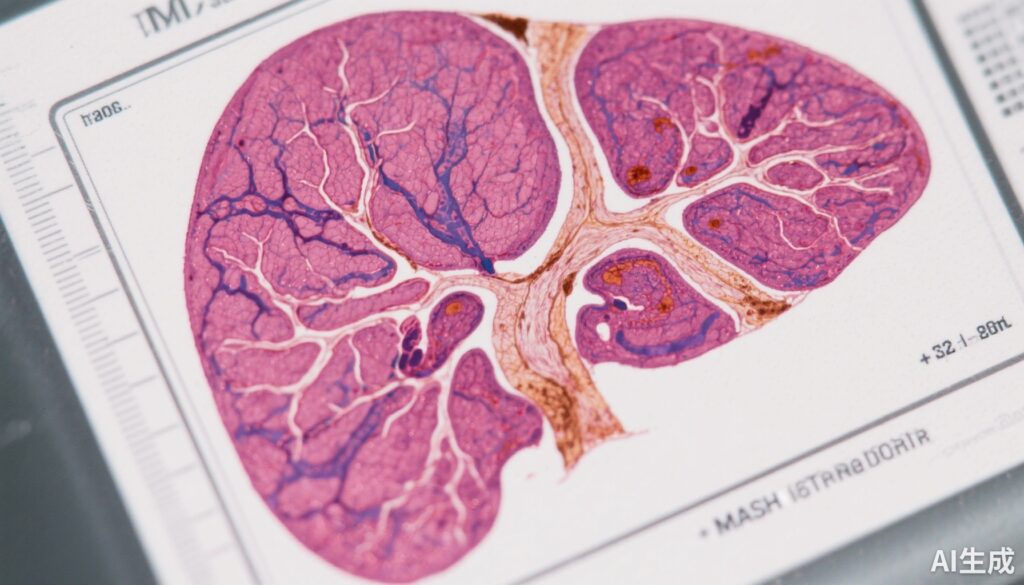Study background and disease burden
Metabolic dysfunction-associated steatohepatitis (MASH), formerly recognized within the spectrum of nonalcoholic steatohepatitis (NASH), is an increasingly prevalent liver condition marked by hepatic inflammation, steatosis, and progressive fibrosis, often linked with metabolic comorbidities such as type 2 diabetes mellitus and obesity. Fibrosis progression in MASH drives the risk of cirrhosis, liver failure, and hepatocellular carcinoma, representing a significant clinical challenge with limited approved pharmacotherapies to date. Integral to MASH pathogenesis are mechanisms involving glycaemic dysregulation, chronic low-grade inflammation, and lipid metabolism abnormalities.
Free fatty acid receptors (FFARs), specifically FFAR1 and FFAR4, are G-protein coupled receptors expressed on multiple cell types including hepatocytes, immune cells, and pancreatic beta cells. They modulate glucose homeostasis, insulin sensitivity, and inflammatory responses, suggesting their dual role as attractive therapeutic targets in MASH. Icosabutate, an oral dual FFAR1/FFAR4 agonist, was developed to leverage these mechanisms to improve liver histology and systemic metabolic parameters.
Study design
The ICONA study was a 52-week, phase IIb, multicentre, randomised, placebo-controlled trial designed to evaluate oral icosabutate’s safety and efficacy in adult patients with histologically confirmed MASH and fibrosis stages F1 to F3 (mild to severe fibrosis but no cirrhosis). A total of 187 patients were randomized in a 1:1:1 ratio to once-daily oral administration of 300 mg icosabutate, 600 mg icosabutate, or placebo. The primary endpoint was the proportion of patients in the 600 mg arm achieving histological resolution of MASH without worsening fibrosis at one year.
Secondary endpoints included ≥1-stage improvement in fibrosis assessed by liver biopsy using conventional histopathology and AI-assisted digital pathology, changes in circulating biomarkers of liver injury and inflammation, glycaemic control parameters, and safety/tolerability metrics.
Key findings
Among the 187 patients analyzed (placebo n=62; 300 mg n=58; 600 mg n=67), treatment with 600 mg icosabutate showed a non-significant numerical advantage in MASH resolution without fibrosis worsening compared to placebo (23.9% vs. 14.5%; odds ratio 2.01; 95% CI 0.8 to 5.08; p=0.13). Although not meeting the pre-specified primary endpoint, these results suggest a potential trend towards benefit.
Importantly, both 300 mg and 600 mg icosabutate groups demonstrated higher rates of ≥1-stage fibrosis improvement compared with placebo: 29.3% for 300 mg (odds ratio 2.89; 95% CI 1.09 to 7.70) and 23.9% for 600 mg (odds ratio 2.4; 95% CI 0.90 to 6.37) versus 11.3% in the placebo arm. This fibrosis benefit was corroborated by AI-assisted digital pathology, which offers a sensitive and quantitative measure of fibrosis changes.
Additionally, patients treated with icosabutate exhibited marked reductions in serum biomarkers indicative of liver damage and inflammation. Improvements were also observed in metabolic parameters related to glycaemic control, aligning with FFAR1/FFAR4’s mechanistic roles.
Safety analyses revealed icosabutate to be generally well tolerated, with mild to moderate treatment-emergent adverse events reported. Notably, no drug-induced liver injury was observed, underscoring a favorable safety profile in a population vulnerable to liver-related adverse events.
Expert commentary
The ICONA trial provides encouraging early-phase evidence supporting the therapeutic targeting of FFAR1 and FFAR4 in MASH. Despite the failure to meet the primary histological endpoint with statistical significance, the robust fibrosis improvements, seen across conventional and novel AI-based histology assessments, highlight icosabutate’s promise. Given fibrosis stage is the strongest predictor of adverse clinical outcomes in MASH, antifibrotic effects are particularly clinically meaningful.
The discordance between fibrosis improvement and lack of statistically significant MASH resolution may derive from study power, heterogeneity of disease, or nuances of histological endpoints, which have known limitations. The AI-assisted digital pathology adds an innovative and more sensitive lens to detect subtle fibrosis changes undetectable by conventional scoring.
Ongoing challenges include refining patient selection, as subgroup analyses suggest that patients with more advanced fibrosis (F2-F3) and concomitant type 2 diabetes may derive greater benefit. Combining metabolic and anti-inflammatory effects addresses the multifaceted pathophysiology of MASH, supporting icosabutate’s rationale.
Future studies with larger, enriched cohorts and longer follow-up are needed to establish definitive clinical benefit and impact on liver-related outcomes. The ICONA data complements emerging evidence implicating FFAR agonism as a viable pharmacologic class in fatty liver diseases.
Conclusion
The phase IIb ICONA study of icosabutate demonstrated a favorable safety profile and encouraging evidence of fibrosis improvement in patients with fibrosing MASH. Although the primary endpoint of MASH resolution without fibrosis worsening was not met, the overall histological, biomarker, and metabolic data warrant further clinical development of icosabutate. This includes potential targeted use in patients with more advanced fibrosis and metabolic comorbidity. Icosabutate may represent an innovative therapeutic strategy addressing key pathogenic axes in MASH, a pressing unmet need in hepatology.
Reference
Harrison SA, Alkhouri N, Ortiz-Lasanta G, Rudraraju M, Tai D, Wack K, Shah A, Besuyen R, Steineger HH, Fraser DA, Sanyal AJ; ICONA Study Investigators. A phase IIb randomised-controlled trial of the FFAR1/FFAR4 agonist icosabutate in MASH. J Hepatol. 2025 Aug;83(2):293-303. doi: 10.1016/j.jhep.2025.01.032. Epub 2025 Feb 10. PMID: 39938653.



